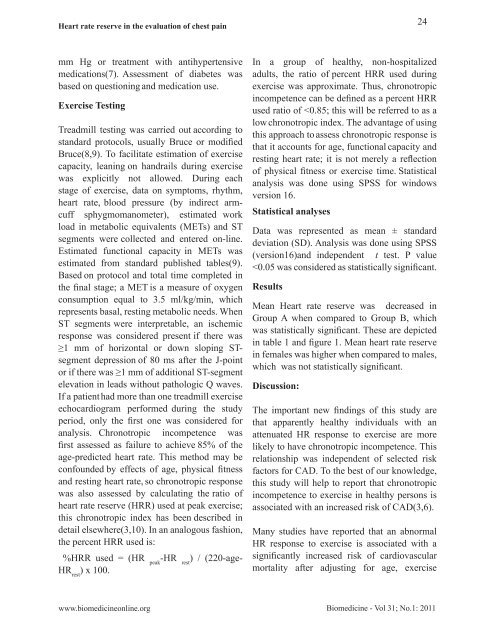An International Journal for Biomedical Sciences - Biomedicine
An International Journal for Biomedical Sciences - Biomedicine
An International Journal for Biomedical Sciences - Biomedicine
Create successful ePaper yourself
Turn your PDF publications into a flip-book with our unique Google optimized e-Paper software.
Heart rate reserve in the evaluation of chest pain<br />
mm Hg or treatment with antihypertensive<br />
medications(7). Assessment of diabetes was<br />
based on questioning and medication use.<br />
Exercise Testing<br />
Treadmill testing was carried out according to<br />
standard protocols, usually Bruce or modified<br />
Bruce(8,9). To facilitate estimation of exercise<br />
capacity, leaning on handrails during exercise<br />
was explicitly not allowed. During each<br />
stage of exercise, data on symptoms, rhythm,<br />
heart rate, blood pressure (by indirect armcuff<br />
sphygmomanometer), estimated work<br />
load in metabolic equivalents (METs) and ST<br />
segments were collected and entered on-line.<br />
Estimated functional capacity in METs was<br />
estimated from standard published tables(9).<br />
Based on protocol and total time completed in<br />
the final stage; a MET is a measure of oxygen<br />
consumption equal to 3.5 ml/kg/min, which<br />
represents basal, resting metabolic needs. When<br />
ST segments were interpretable, an ischemic<br />
response was considered present if there was<br />
≥1 mm of horizontal or down sloping STsegment<br />
depression of 80 ms after the J-point<br />
or if there was ≥1 mm of additional ST-segment<br />
elevation in leads without pathologic Q waves.<br />
If a patient had more than one treadmill exercise<br />
echocardiogram per<strong>for</strong>med during the study<br />
period, only the first one was considered <strong>for</strong><br />
analysis. Chronotropic incompetence was<br />
first assessed as failure to achieve 85% of the<br />
age-predicted heart rate. This method may be<br />
confounded by effects of age, physical fitness<br />
and resting heart rate, so chronotropic response<br />
was also assessed by calculating the ratio of<br />
heart rate reserve (HRR) used at peak exercise;<br />
this chronotropic index has been described in<br />
detail elsewhere(3,10). In an analogous fashion,<br />
the percent HRR used is:<br />
%HRR used = (HR peak -HR rest ) / (220-age-<br />
HR rest ) x 100.<br />
24<br />
In a group of healthy, non-hospitalized<br />
adults, the ratio of percent HRR used during<br />
exercise was approximate. Thus, chronotropic<br />
incompetence can be defined as a percent HRR<br />
used ratio of


